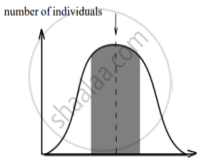Advertisements
Advertisements
प्रश्न
The graphs below show three types of natural selection. The shaded areas marked with arrows show the individuals in the population who are not selected. The dotted vertical lines show the statistical means.
 |
 |
 |
| character Graph A |
character Graph B |
character Graph C |
- What names are given to the types of selection shown in graphs A, B and C?
- After the selection has operated for several generations in the above populations indicated as, Graph A, B and C, graphically illustrate the probable results.
उत्तर
- A - stabilising; B - directional; C - disruptive;
- Graph A - Stabilising
Graph B - Directional
Graph C - Disruptive
APPEARS IN
संबंधित प्रश्न
Differentiate between Directional natural selection and Disruptive natural selection.
Multiple choice question.
In Hardy - Weinberg equation, the frequency of homozygous recessive individual is represented by:
A population will not exist in Hardly Weiberg equilibrium if ____________.
Which type of selection explains industrial melanism observed in moth, Biston bitularia ______.
How is Hardy-Weinberg's expression “(p2 + 2pq + q2) = 1” derived?
List any two factors that can disturb the genetic equilibrium.
State Hardy Weinberg's principle.
Give a mathematical expression for Hardy Weinberg's principle.
A population of 200 fruit flies is in Hardy Weinberg equilibrium. The frequency of the allele (a) 0.4. Calculate the following:
Frequency of the allele (A).
The black colour on the beak of finches dominates over the yellow colour. There are 210 individuals with the genotype DD, 245 individuals with the genotype Dd and 45 individuals with the genotype dd. Deduce the frequency of individuals with dominant, heterozygous, and recessive traits.
